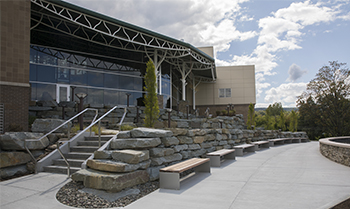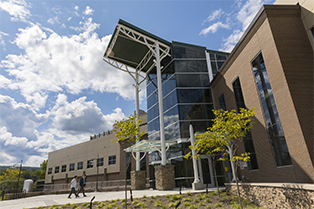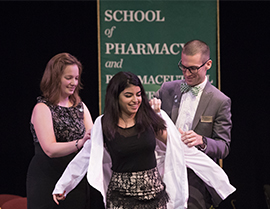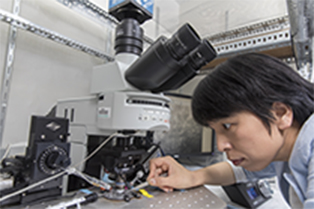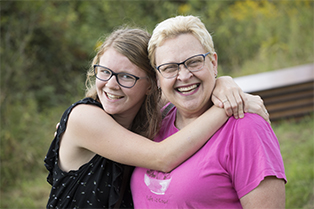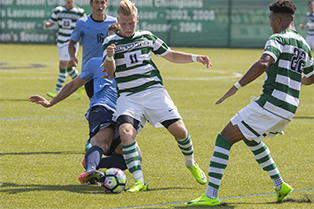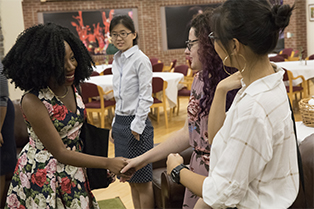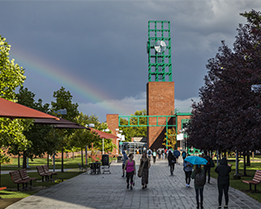Binghamton University President Harvey Stenger's Road Map Quarterly Report - September 30, 2017
September is a special time of year at Binghamton University. The skies are clear, the trees begin to turn and there’s a buzz in the air as students return campus, new faculty and staff acquaint themselves with the Binghamton community and everyone gets to work doing the business of a premier public university.
This new academic year is especially promising, as a number of significant initiatives, years in the making, are coming to fruition. These include the development of new schools, the completion of new facilities and creation of new programs to strengthen our community and campus. At the same time, our Road Map strategic planning process and the Road Map Renewal that concluded this summer are providing new directions for campus growth and development.
Starting the academic year
The campus got off to a good start in August when we welcomed back our students, including 2,660 new freshmen, around 1,100 transfer students as well as 1,360 new graduate students. This brings campus enrollment to nearly 17,500 for the 2017-18 academic year, very close to what our enrollment was last year. This is another outstanding class of students, perhaps the best we’ve ever had, based on their academic records. Student SAT scores are about 1360, with an average high school GPA of 95.
One reason that student quality continues to get better is because of the increasing interest we are getting. This past year we had a record 33,406 applications, up 4 percent from last year, which was itself a record.
Among our new students are the inaugural class for our School of Pharmacy and Pharmaceutical Sciences (SOPPS). They, too, come to Binghamton with excellent credentials – a number of them did their undergraduate work at Binghamton – and are getting the program off to an excellent start. But this is just the beginning — over the next three years we will growing enrollment as new classes come on board, so that in four years’ time, we’ll have about 360 SOPPS students at the University.
On Sept. 9, our new pharmacy students participated in the school’s first White Coat Ceremony, donning their “white coats” that mark their entry into clinical work as medical professionals. This is a tradition that many medical programs have that helps reinforce the professional obligations that students working in clinical settings have to their patients.
In my remarks at the ceremony, I spoke about our expectations for these students and the high bar they set for future classes. I also touched on the expectations I have for the school and the challenges we’ve overcome to make it happen. To move so quickly from the vision of a new pharmacy school in 2012 to bringing in its first class in just five years is a remarkable accomplishment for the University, and I appreciate the work that Dean Gloria Meredith and her faculty and staff have done to make it happen.
The quality of our academic programs and our students are reflected in the rankings we receive in the media. This year, Binghamton has once again made the list of U.S. News & World Report’s top 100 universities. Binghamton is now nearing our third decade on this list. At number 87, we are the highest-ranking SUNY on the list.
These rankings are a mixed bag for campuses. On one hand we appreciate the recognition they bring, but they also tend to look at the campus with a very broad brush that misses many of the things that I think make Binghamton unique.
Nonetheless, getting noticed helps – especially when it comes to recruiting top-flight students. It also helps us recruit the faculty who will teach these students. This year, we’ve added a net of 10 new tenure-track (TT) faculty, bringing the total number of TT faculty to 620. We are nearing the end of the largest hiring initiative in the University’s history, one that has added nearly 150 new TT faculty over the past five years for a 31 percent increase in that period of time. We will continue to bring in new faculty depending on program needs and resource availability.
In addition to new faculty, the summer also brought us two new deans — Harpur College Dean Elizabeth Chilton joined us in July from the University of Massachusetts Amherst, where she was professor of anthropology and associate vice chancellor for research and engagement. And in August, Aondover Tarhule joined the University community as vice provost and dean of the Graduate School. He previously served as professor of geography and executive associate dean in the College of Atmospheric & Geographic Sciences at the University of Oklahoma.
Not long after the semester started, the campus took time to welcome the parents and family members of our students to campus as part of our annual Family Weekend. This year, 1,329 families and more than 4,500 individuals came to campus, including parents, grandparents and siblings.
This was an event-filled weekend, with programs taking place on both our Vestal and downtown Binghamton campuses. Our Office of Parent and Family Programs worked with campus offices, student groups and community organizations to develop a program of more than 100 different events.
The weekend is designed to be both informative and fun, with programs designed to help parents be an active part of their students’ education. Highlights included informational sessions from the Fleischman Center for Career and Professional Development, the Decker Student Health Services Center and the Division of Research, as well as concerts, dance presentations by resident artists Galumpha and, of course, sports competitions involving our men’s and women’s soccer squads and a number of our club sports teams. And lest I forget, Baxter had his photo taken nearly 350 times in just three days.
Family weekend also saw the celebration of the Binghamton University Art Museum’s 50th anniversary, which was celebrated with a formal reception and tour of the museum. The museum plays a key role on campus, helping students and faculty get a feel for the civilizations, societies and cultures that have produced its collections. In the years prior to the establishment of the museum, faculty and students would hold exhibitions in the campus cafeteria; the campus is proud to now provide our holdings a truly world-class home.
Chabad, which serves as a home away from home for our Jewish students, celebrated Family Weekend with the installation of the new Binghamton Legacy Torah, which will now serve as the centerpiece of Jewish life on campus. The Torah was commissioned by thousands of Binghamton students, parents and alumni, and links together the entire Jewish community on campus – past, present and future.
Tobacco-free campus
Even as we were welcoming new students, faculty, staff and family members to campus, we were saying goodbye to something that won’t be terribly missed – tobacco. The University became a tobacco-free campus on Aug. 1. The decision to go tobacco free reflects one of our key missions – to be a healthy campus that fosters health and wellness, safety and sustainability. Tobacco use on campus ran against these goals. We are emphasizing community norms to help reduce tobacco usage on campus. This transition has been in process for over a year, and the campus is reminded that there is support for those who wish to stop using tobacco products, including smoking-cessation classes, nicotine-replacement therapy and the Healthy Practices Clinic.
New facilities
In August, we welcomed New York State Sen. Fred Akshar and Assemnblywoman Donna Lupardo to campus to help us open our new Smart Energy Building at our Innovative Technologies Complex. The planning for this facility dates back to 2012, when we first approached Gov. Andrew Cuomo with our plans to expand our campus as part of his NYSUNY 2020 initiative. With its opening, the Smart Energy Building now houses our chemistry and physics departments. The research conducted in the facility will largely focus on cutting-edge energy research and development, including harvesting and storage in areas such as thin-film solar panel design and production, consumer-ready solar cells and next-generation battery production.
During the opening, we also recognized one of our distinguished faculty leaders, Distinguished Professor M. Stanley Whittingham. His work is central to our smart-energy efforts, as he is one of the co-inventors of the lithium Ion battery that powers so much of our lives these days. During his time at Binghamton, he established the Materials Science and Engineering program and is currently administering a $12.8 million U.S. Department of Energy grant to foster scientific breakthroughs needed to build a new 21st-century energy economy. His work stands as testimony to our commitment to research that can produce sustainable technologies that change the world, and at the same time, strengthen our community through innovations that lead to new jobs.
Sen. Akshar and Assemblywoman Lupardo were also on hand in June for the opening of the Koffman Southern Tier Incubator in downtown Binghamton. Like our Smart Energy Building, the incubator was also years in the making, and was one of my first priorities when I came to Binghamton. Financial support for the facility came primarily from New York state’s Regional Economic Development Council (REDC) initiative, as well as funding from the NYSUNY 2020 legislation in 2012.
The Incubator is designed to serve as a link between University research and the region’s entrepreneurs, supporting collaboration that will provide fast access to technical expertise, innovative research partners and state-of-the-art laboratory equipment that will give entrepreneurs a significant advantage as they bring their products to market.
When it opened it already housed seven different firms, with an additional 10 more firms approved and online to begin their work. It is also the new home for the University-affiliated Small Business Development Center and the Trade Adjustment Assistance Center. As the facility comes fully online, we expect that there will be at least a half-dozen companies “graduating” from the Incubator each year as they start moving into community locations.
Sadly, in late September we learned that Bud Koffman, for whom the Incubator is named, had died. He was a great supporter of the University and of entrepreneurs throughout the Southern Tier, and the support he and his wife Ruthanne provided for the incubator substantially reduced the overhead costs companies working in the incubator incur, so they can become profitable and productive more quickly. He will be missed by the University and the community.
The Koffman Southern Tier Incubator is only one of the many ways that the University is supporting economic growth in the community. Every year, the campus has a bigger and bigger impact on the region’s economic, social and cultural development. As one of the area’s largest employers, we have an outsized influence on the economic life of the region. We now account for 13 percent of the region’s economic activity, with our most recent economic impact statement showing that we have an impact of over $1.13 billion on the region, and over $1.5 billion on the state, according to the University’s latest economic impact report, which was released in late May.
Other highlights of the report include:
• 68,000 alumni remain in New York.
• Every state dollar used to support the campus generates $9 in return.
• Binghamton University employs more than 5,200 people (c.2015), and our activity supports an additional 7,000 people in Broome and Tioga counties.
State of the University
Early in September, I spent some time talking to some of those 5,200 faculty and staff at my annual State of the University address. During the State of the University, I highlight recent successes, but more importantly, discuss the environment we operate in and our strategic priorities for the coming year.
Binghamton University and the State University of New York (SUNY) will see some changes this year, as we have a new chancellor. Kristina Johnson comes to SUNY with a background in academia, industry and governmental work and has indicated that she wants SUNY institutions to grow research and scholarship, focus on environmental sustainability and intervene more quickly to support student academic success. Binghamton is well positioned in these areas, and I believe that the new leadership at SUNY will continue to value our efforts.
Other changes may be more challenging. Demographic trends suggest that we will face a declining number of high school graduates in the Northeast, increasing competition for quality students among our peer institutions. State support for higher education will likely remain flat for the foreseeable future, so we will need to develop new and expand existing sources of revenue, including external funding from federal grants, as well as private support. Nationally, colleges and universities are part of a larger discussion about the role of international and undocumented students, and the continuing need to balance free speech with the respectful dialogue necessary to ensure institutions of higher education remain welcoming and inclusive.
The Binghamton University Road Map Renewal that began last January concluded in late May, with a number of recommendations for future projects and initiatives. The Road Map Steering Committee identified four of these as “University Initiatives” that will be pursued in the coming years. These include:
• Establishment of the Decker School of Nursing and Health Sciences that will expand the offerings of our nursing school into allied healthcare fields such as physical and occupational therapy, speech therapy and nutrition.
• Development of a health sciences core facility so that researchers in fields associated with the health sciences will have access to the powerful new technologies they need to excel in their disciplines.
• Development of new programs in big data science so that faculty and students across the campus, including those in the social sciences and humanities, can work with large databases.
• Investment in a new, minority post-doctoral fellowship program to help us attract and retain promising faculty of color, especially in disciplines that have historically struggled to recruit these faculty.
These are our big-ticket, University-wide initiatives – but the divisions also have many of their own projects to improve the campus academic, student-service and community-outreach missions.
As you can see, it’s been a very exciting and productive start to the new academic year and I’m looking forward to seeing what the rest of the fall semester brings.
Sincerely,

Harvey G. Stenger

